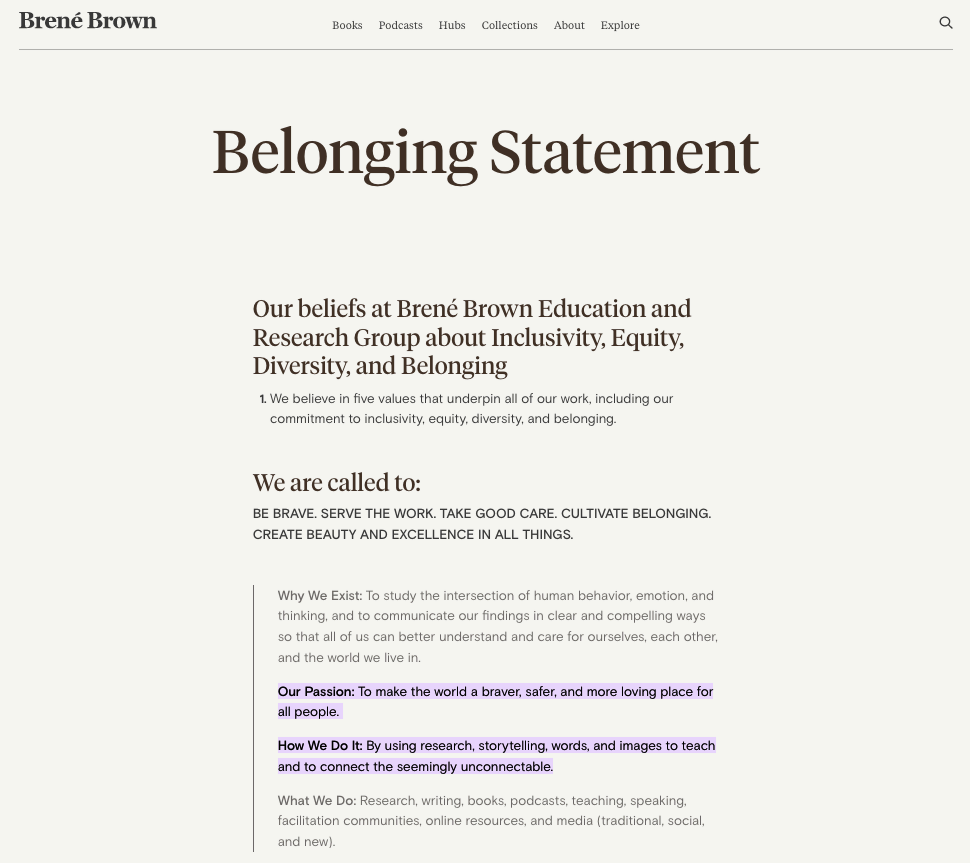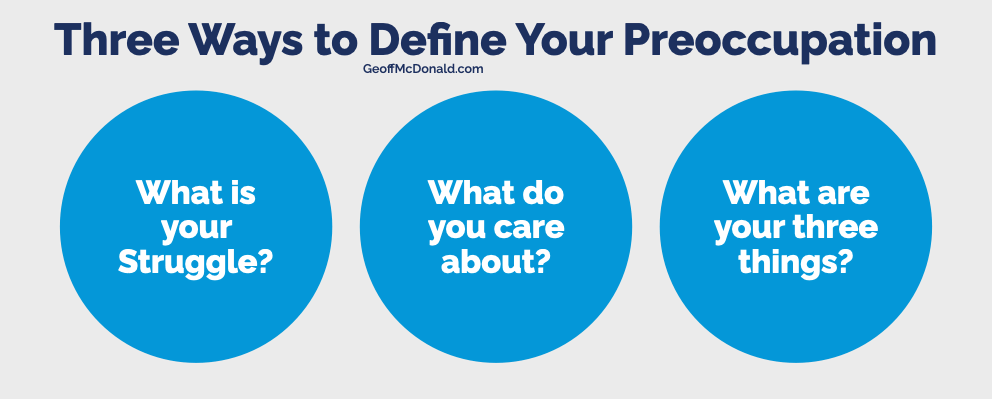Do thought leaders need a mission statement?
In my previous post, I shared three examples of Mission Statements from leading Content Creators. In this post, we’re looking at Mission Statement examples from Thought Leaders.
What’s the difference between a Content Creator and a Thought Leader?
Which begs the obvious question: What’s the difference between a content creator and a thought leader?
First, to be a thought leader you need to be a content creator in some way – either through articles, books, presentations, research papers etc. In this way, thought leaders are just like content creators.
Second, a thought leader is seen as the go-to person in an industry or the leader of a conversation. They stand out as an expert in some way. In this way, thought leaders are not like most content creators.
Thought Leadership Mission Statements
What does this mean about their mission statements? Do thought leaders even need one?
To answer this question, I did some research.
I made a list of 25 people I consider to be thought leaders. I started with the seven people who were my examples of Thought Leaders in a previous post: What is Thought Leadership: Seven Thought Leadership Examples. Then I went through some of the authors of books that I’ve read or followed over the past few years. After that, I googled ‘examples of thought leaders’ to add the remaining people to my list.
This made my list of 25 people – 13 men and 12 women. Some you might have heard of and some you might not have heard of.
The 25 thought leaders are: Cal Newport, Brene Brown, Eric Barker, Elizabeth Blackburn, Jacinda Ardern, Bernard Salt, Greta Thunberg, Tim Ferriss, Seth Godin, Dan Pink, Barbara Kellerman, Heidi Grant, Ori Brafman, Rahaf Harfoush, Eric Ries, Sheryl Sandberg, John Jantsch, Donald Miller, Gary Vaynerchuk, Jeanne Bliss, Laura Goodrich, Yuval Noah Harari, Morag Barrett, Arianna Huffington and Stan Grant.
Then I googled each person on my list to look for two things.
- One, did they have a mission statement?
- And two, which mission statement template did they use?
Four Thought Leadership Mission Statement Examples
But what I found surprised me.
When I searched for content creators’ mission statements in the previous post, 8 out of 21 people had one on their sites. I expected something similar.
For my list of thought leaders, I found a couple of mission statements for businesses that people ran.
Gary Vaynerchuk
For instance, Gary Vaynerchuk had one for Vayner Media that he spoke about informally in this video.
“help clients, whether they’re an NGO or nonprofit or selling bottled water, help them sell stuff communicate at the best possible price in the best possible channels to reach the biggest possible audience to create that business result”.
Brene Brown
Brene Brown had a Belonging Statement for her business. This makes perfect sense because all of her work is about belonging.
Morag Barrett
Morag Barrett from Skye Team had a list of company values, but not a mission statement.
Jeanne Bliss
The closest thing to a personal mission statement was from Jeanne Bliss. She had a Purpose statement which is similar to but different to a mission statement.
So, if almost none of the Thought Leaders I researched – and 25 is a modest sample size – don’t have a mission statement, then this suggests that Thought Leaders don’t need a mission statement.
I didn’t see that coming when I started researching this video.
The Three Reasons for having a Mission Statement
This forced me to question, what purpose does a mission statement play? And why would someone need one?
I think there are three things that a mission statement can provide.
One, it inspires you. It’s the thing that drives you to get up out of bed in the morning and into your day.
Two, it gives you focus and helps you stay on track consistently over time. If you don’t have that level of focus over time you won’t make it as a thought leader.
And three, it reminds you what action you need to take. This might be as general as a personal exploration or a specific way that you help others.
If thought leaders don’t use a mission statement then what do they use to be inspired, stay focused and stay on track, and take action?
How Thought Leaders Define their Work
The good news is that while I didn’t find mission statements, I did find something else that might be more valuable for content creators and wannabe thought leaders.
Cal Newport
Cal Newport said:
I write about the intersection of digital technology and culture. I’m particularly interested in our struggle to deploy these tools in ways that support instead of subvert the things we care about in both our personal and professional lives.
Laura Goodrich
Laura Goodrich is an expert on transformation and the future of work. On her website it says:
The three things we care about the most.
Future focused thinking
Transforming amidst turbulent times
Understanding the trends of change
Stan Grant
But the wording I loved the most I found on a site about the Australian thought leader Stan Grant.
While Stan doesn’t have his own website, he does have a page on the Australian National University website through which he has published one of his books.
It says his Preoccupations are Aboriginal Identity and Colonial History.
I love that – Preoccupations.
What is your Preoccupation?
Let’s look at the definitions here of the word Preoccupy (from Oxford Languages and Google)
A subject that dominates or engrosses the mind to the exclusion of other thoughts.
For me, that fits most thought leaders – they are preoccupied by something such that they spend a lot of time exploring and studying it. And that’s how they become a thought leader.
Instead of asking yourself ‘What is your mission?’, if you want to be a thought leader then you need to ask yourself, ‘What are you preoccupied with?’
Just as a curious aside, I also found this.
Google Books Ngram Viewer tells you the number of times a word is used in books over time. In this case, the word ‘Preoccupy’ has been used four times more often in the last 20 years than one hundred years ago. I’m not sure why. In my experience, it’s more likely that more people are distracted than ever rather than wanting to be thought leaders. But I could be wrong.
How can you use these insights?
My research has now found two things.
- The first is that from my sample of 25 people, most thought leaders don’t have a mission statement. Their business might, but they don’t have a personal mission statement.
- And second, instead of a mission statement, they do have a preoccupation – something captures their attention, and they think about it a lot.
So how can you use this? How can you frame up your preoccupation so that it serves the three roles of a mission statement:
- Inspire
- Focus
- Action
The obvious place is to review what some of our thought leaders did say on their websites that show how they describe their preoccupation.
Three Ways to Position your Thought Leadership Work
Cal Newport’s Struggle
Let’s start with Cal Newport. He simply says I write about this.
I write about the intersection of digital technology and culture.
Then he says something interesting:
I’m particularly interested in our struggle to deploy these tools in ways that support instead of subvert the things we care about in both our personal and professional lives.
Importantly he also points to the struggle. He doesn’t write about it to give a definitive answer. He writes about it to explore it.
And I’m guessing but his self-interest is that he wants to find answers for his own benefit as well as for the benefit of others.
What’s the thing that you struggle with? Or see other people struggle with?
For me, my ongoing struggle is how to make money from my ideas. And I know through my clients that other people are interested in this as well.
What Laura Goodrich cares about
Laura Goodrich says it differently. She simply says these are the three things we care about.
On her website it says, the three things we care about the most.
And I like this line: We’re dedicated to paving new roads, shattering old ideas and embracing new ones. That’s a good description of what I care about too – but in a different area.
What do you care about?
What TED, Daniel Pink and Rahaf Harfoush have in common
Our third example is an easy one if you’re not sure where to start. And it can most definitely last a lifetime too. It’s simply to gather three things you’re interested in and put them together.
Our first example is not an individual thought leader but a good example of where a lot of thought leaders hang out.
It’s TED. And TED stands for Technology Entertainment and Design. That’s a pretty wide-reaching topic.
For Daniel Pink, it’s four things – business, work, creativity and behaviour.
For Rahaf Harfoush, it’s leadership, emerging technologies and digital culture.
 Your Three Things of Interest
Your Three Things of Interest
And for me, I think a great way to show this visually is to draw a simple set of three overlapping circles.
And I like this because it recognises it’s the overlap or the intersection between these elements and that is where the most interesting ideas will occur.
Also, this simple process of picking three things provides lots of variation. For instance, the 25 thought leaders on my list could use the same three circles but they would all come up with something very different.
What are your three things?
More on Thought Leadership and Mission Statements
That was a surprise result. I went looking for mission statements by thought leaders and when I didn’t find that, I found something else that was way more interesting.
I found that instead of a mission, they define their work based on what they think about a lot of the time. That makes a lot of sense.
And their examples give you three ways to define your preoccupation or area of exploration:
- What is your struggle?
- What do you care about?
- What are your three things?
How this has changed my work
The research for this video has really shaken up my thinking. I had been looking at creating a mission statement for myself and now I’m not going to do that.
In my next post, I’ll share my examples of how I’ve explored the three types of preoccupations. And most importantly, what this means for what I’m going to create next.
Three Related Posts
For more on thought leadership and mission statements here are three related posts:
- What is Thought Leadership? Seven Examples
- Inspiring mission statement examples from the best content creators
- Three big reasons to write a thought leader manifesto
I’d love to hear what you think of this. Add a comment below and let me know. For bonus points, what’s your preoccupation?









 Your Three Things of Interest
Your Three Things of Interest


